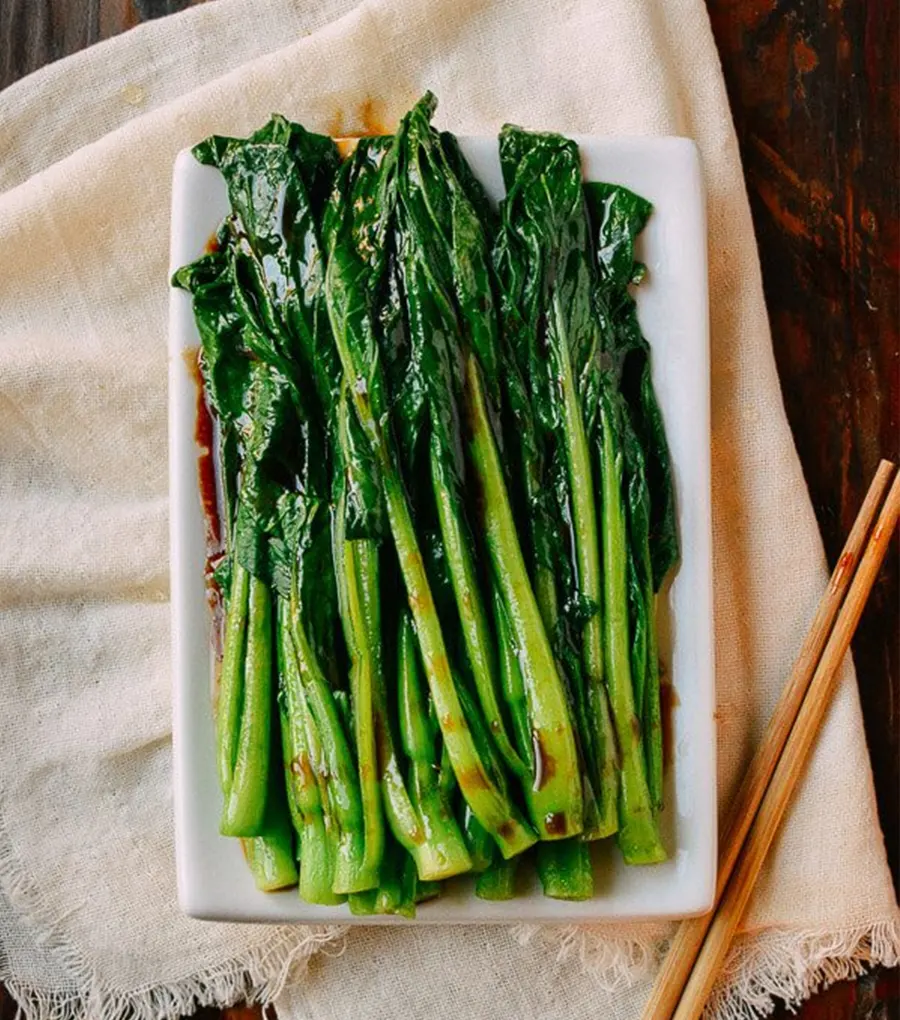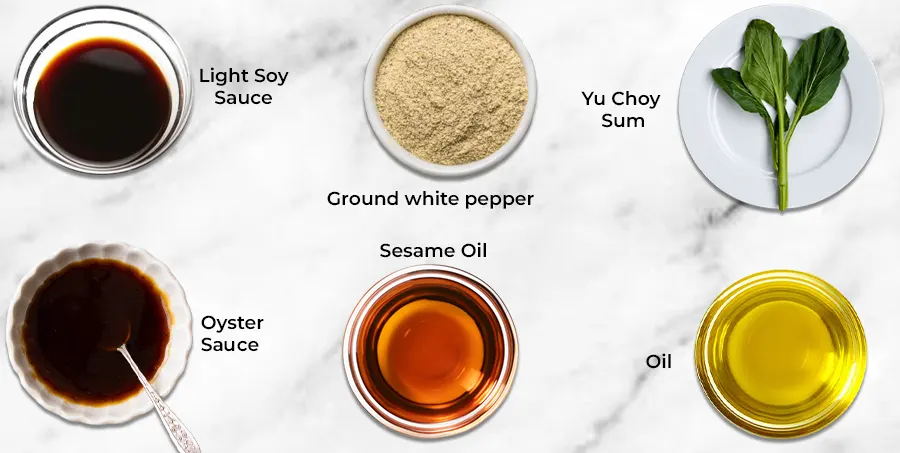Easy Chinese Yu Choy Sum Recipe

Are you looking for a Chinese fusion in a soup? If that is the thing, then try this Yu Choy Sum recipe at home and make a delicious and flavorful Chinese soup for your family members. As the name says, Yu Choy Sum is a leafy green vegetable commonly used in Chinese cuisine. The slender stems and dark green leaves are used for making soup. It is highly nutritious and a staple in Chinese cuisine. The blend of simple, flavorful ingredients makes this a special dish liked by my family. Here is a simple and delicious recipe below with a list of ingredients and instructions. Please note that you should just follow the instructions step-by-step.
Contents
-
What is so special about the Chinese Yu Choy Sum Recipe?
-
Chinese Yu Choy Sum Recipe Ingredients
-
How to Make Chinese Yu Choy Sum
-
Recipe Tips and Notes
-
Nutrition Facts
-
FAQ
What is so special about the Chinese Yu Choy Sum recipe?
The Chinese Yu Choy Sum has many special features that contribute to the liking of the recipe. First, it has high nutritional value and is packed with vitamins and minerals, fiber, etc. It has a wide array of health benefits, fewer calories, and high nutrients, making it an all-rounder, a healthy, balanced diet. Second, you can do various experiments with the ingredients, like simple stir-frying with garlic and the addition of veggies like mushrooms, carrots, and tofu for a rich flavor. Third, it is simple and quick to make. You just need a few ingredients to make the recipe, which are readily available in your kitchen. Therefore, it’s the best option for your busy weekdays when you have something nutritious to offer.
Chinese Yu Choy Sum Recipe Ingredients:
- Yu Choy Sum
- Oil
- Oyster sauce (or vegetarian oyster sauce)
- Light soy sauce
- Sesame oil
- Ground white pepper
How to Make Chinese Yu Choy Sum

First, just give the yu choy a quick wash, making sure to use the three-time rinse method to get rid of all the dirt and sand. In a pot, bring the water to a boil. For thirty seconds, warm up one tablespoon of oil on low heat. within a tiny saucepan. Stir in sesame oil, white pepper, oyster sauce (or vegetarian oyster sauce), and light soy sauce. Simmer for a short while and reserve the sauce. When the water is boiling, add one more tablespoon of oil. After adding the yu choy to the pot, blanch it for thirty seconds. For tender results, you can blanch for an additional minute. To test for doneness, taste a piece. Lift the blanched yu choy out of the water using tongs or chopsticks, then transfer them to a platter. To prevent a watery sauce, make sure any excess water drains. If you’d like, you can cut the long yu choy in half. When the warm sauce is poured over the veggies, your meal is prepared.
Recipe Tips and Notes
Fresh Yu Choy: When buying yu choy, look for vibrant green leaves and firm stems. Avoid bunches with yellowing or wilting leaves, as they may not be as tender.
Blanching Time: The blanching procedure is quick, taking only 30 seconds to a minute. If you like your yu choy to be more tender, you can extend the blanching time slightly. Taste a piece to check for your desired level of doneness.
Draining Excess Water: Extra water on the plate can dilute the sauce, affecting the flavor of the dish.
Serving: Yu choy makes an excellent side dish but is also versatile. You can enjoy it with noodles.
Seasonings: Feel free to adjust the seasonings in the sauce to suit your taste. If you prefer an oyster sauce flavor or a bit more sesame oil, customize the sauce to your liking.
Easy Chinese Yu Choy Sum Recipe
PREP TIME:30 MINUTES || COOK TIME:10 MINUTES || COURSE: SOUP || CUISINE: CHINESE – AMERICANPrepared in less than 10 minutes, this Chinese Yu Choy Sum Recipe is the perfect soup for your family members and kids on busy weekdays. Here’s the best recipe to make it.
Ingredients
- 1 lb (450g) yu choy
- 2 tablespoons of oil (divided)
- 1 tablespoon of oyster sauce (or vegetarian oyster sauce)
- 1 tablespoon of light soy sauce
- 1/2 teaspoon of sesame oil
- 1/8 teaspoon of ground white pepper
Instructions
- To prepare your yu choy, start by giving it a thorough wash, ideally repeating the process three times to ensure every bit of dirt and sand is banished. After this refreshing rinse, get a large pot of water bubbling for the next step.
- While your water is coming to a boil, take a small saucepan (affiliate link), add 1 tablespoon of oil, and gently heat it over low for just 30 seconds. Now, stir in the delectable combination of oyster sauce, soy sauce, sesame oil, and white pepper. Let it gently simmer, then work your culinary magic by turning off the heat and setting it aside for the final touch.
- Once your water has a rolling boil, introduce 1 tablespoon of oil into the mix, then gracefully add your yu choy and give it a gentle stir. Watch in amazement as the yu choy transforms into a vibrant shade of dark green. The entire blanching spectacle unfolds in just 30 seconds, but if your yu choy boasts thicker stems or you prefer a tender crunch, consider extending the dip in hot water by up to a minute. And if you’re a little uncertain, don’t hesitate to pluck a piece for a quick taste test, just like when you’re cooking pasta.
- When your yu choy is ready, employ a trusty pair of tongs or the grace of chopsticks to lift them from their hot water haven and line them up on a dish like honorable soldiers. Keep a keen eye out, as there might be some water trailing behind on the platter. Handle this aqua intrusion with care, as you wouldn’t want your sauce to unexpectedly take a watery plunge.
Nutrition Facts
| Calories: | 98kcal (5%) |
| Carbohydrates: | 5g (2%) |
| Protein | 3g (6%) |
| Fat: | 8g (12%) |
| Saturated Fat: | 1g (5%) |
| Sodium: | 401mg (17%) |
| Potassium: | 10mg |
| Calcium: | 267mg (27%) |
| Iron: | 2mg (11%) |
| Sugar: | 1g (1%) |
| Vitamin A: | 11340IU (227%) |
| Vitamin C: | 144mg (175%) |
DID YOU MAKE THIS RECIPE?
Tag @eatfreshs on Pinterest so we can admire your masterpiece! 🌟
Frequently Asked Questions (FAQ)
Is Yu Choy the same as Chinese broccoli?
No, they are not the same. Chinese broccoli is more bitter with thick stalks and leaves, while Yu Choy is much more tender and sweeter. However, you can substitute one for the other in most Asian dishes, keeping in mind that Yu Choy cooks faster.
What part of Yu Choy do you eat?
You can eat all parts of Yu Choy, including the leaves, stems, and flowers.
How healthy is Yu Choy?
Yu Choy is very nutritious and healthy. It’s rich in folate, vitamin C, and vitamin A, and is a good source of iron. It can be enjoyed as a side dish to help you meet your daily vegetable servings.
Can you eat yellow Yu Choy?
Yes, you can eat yellow Yu Choy, but it’s best to cut off the yellowed parts. Yellowing indicates that the vegetable is past its prime, and the leaves may become limp while the stems turn brown and dry. Trimming the yellowed sections will help improve the taste, although it may lose some of its sweetness when cooked.

NICE TO MEET YOU!
Welcome! I’m Sumi, and I have a love for FOOD. Here, we’re all almost the pleasure of homemade delicious recipes.
Have you tried out one of my recipes? Share your culinary creations with us by tagging @eatfreshs on Instagram – I’d love to see your delicious dishes and connect with enthusiasts like you!



